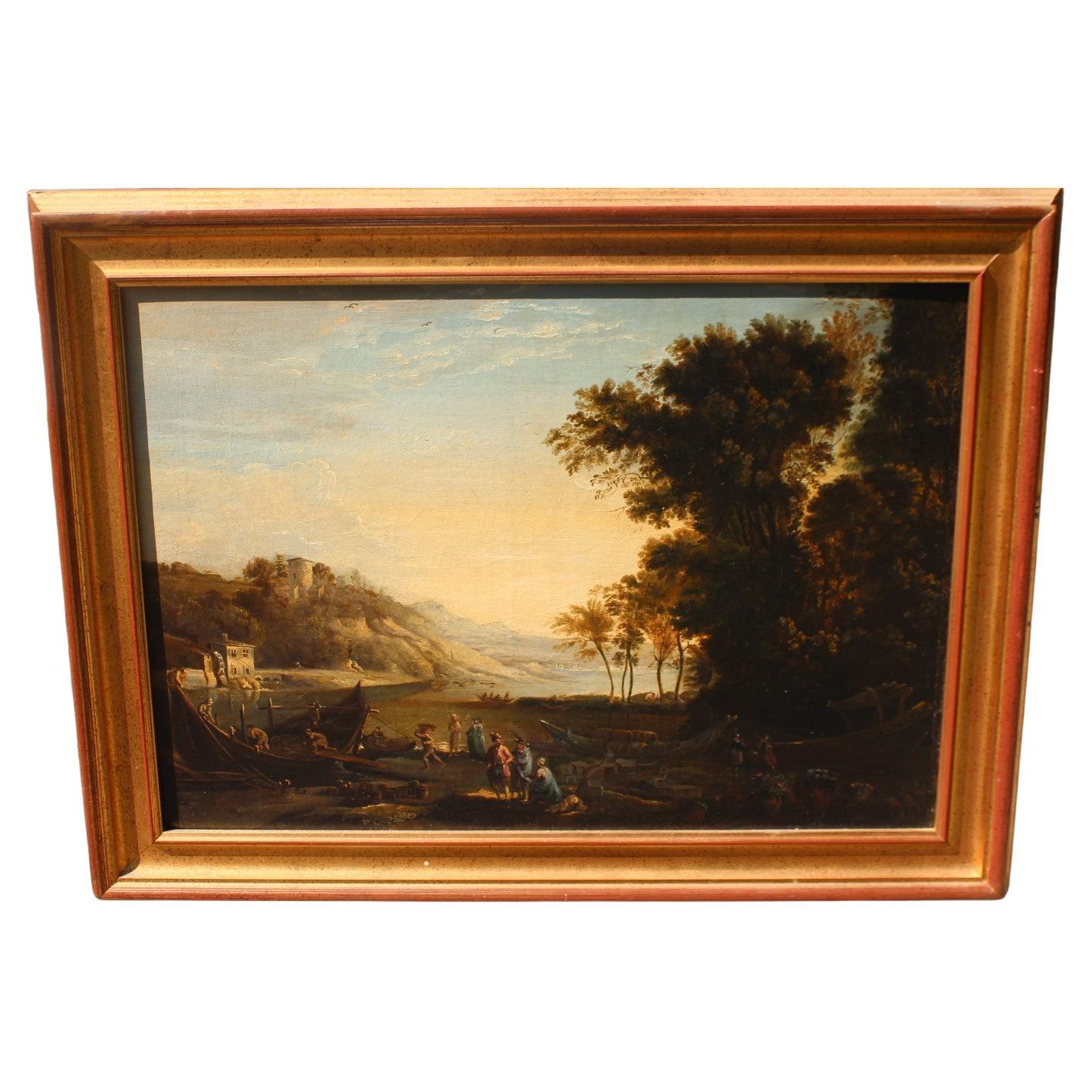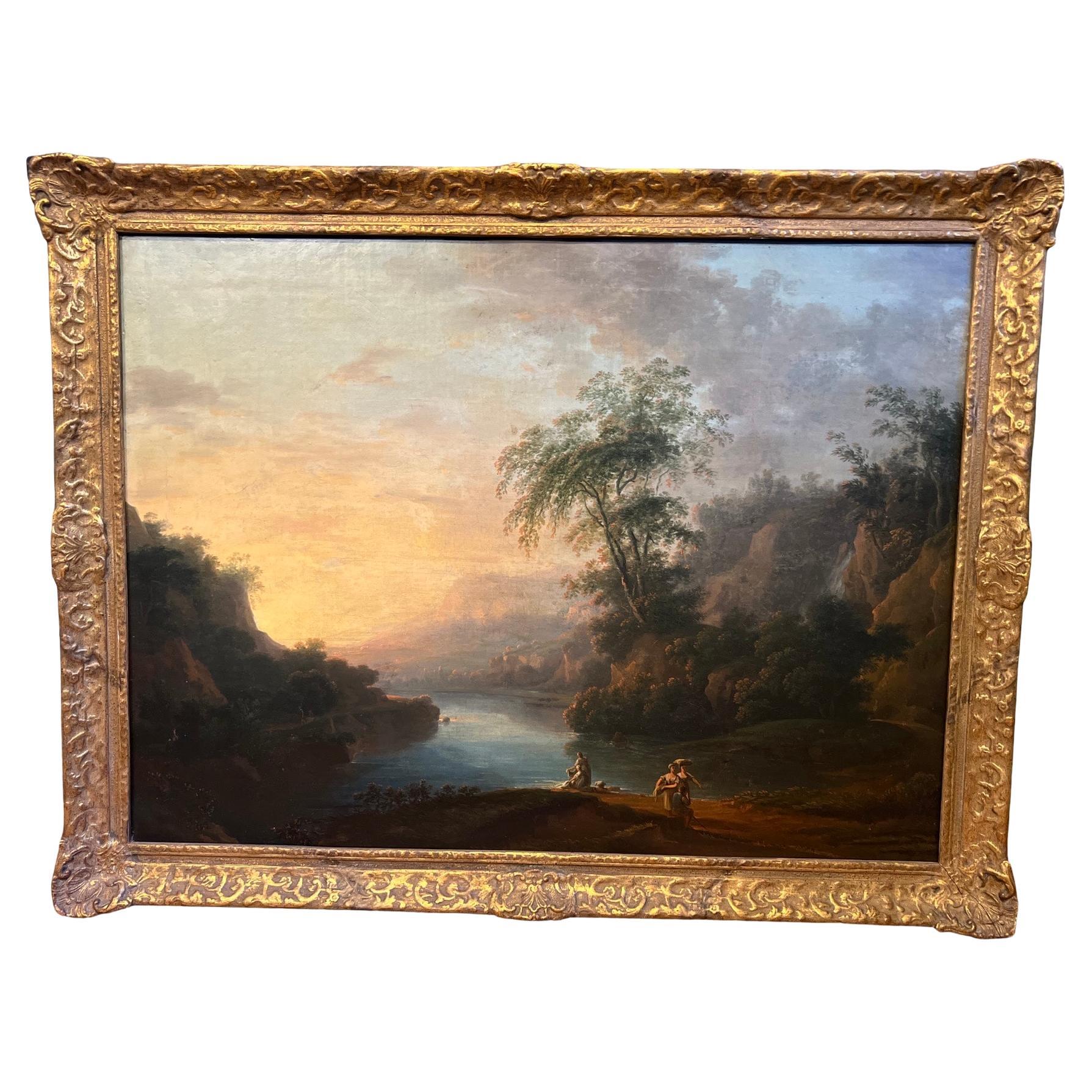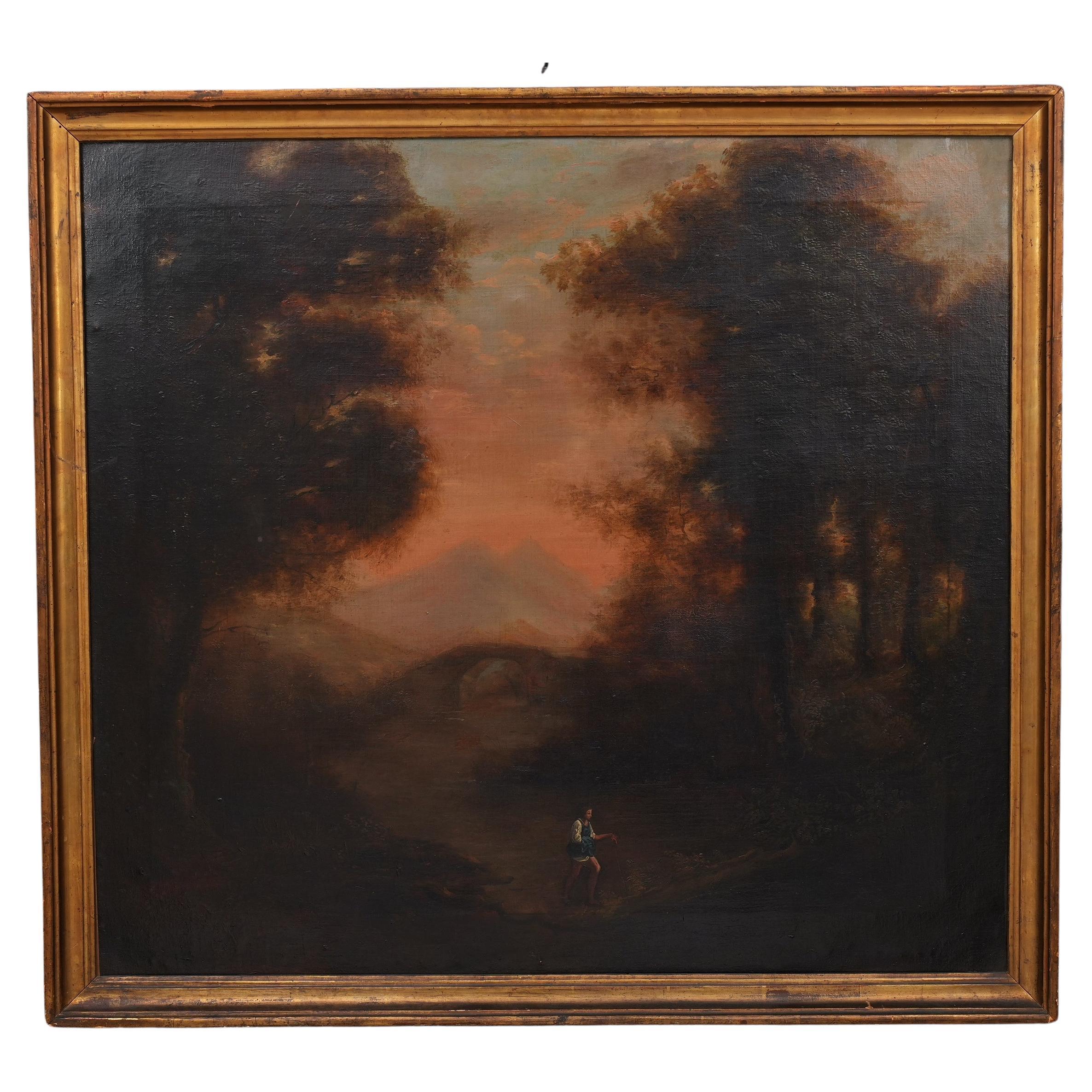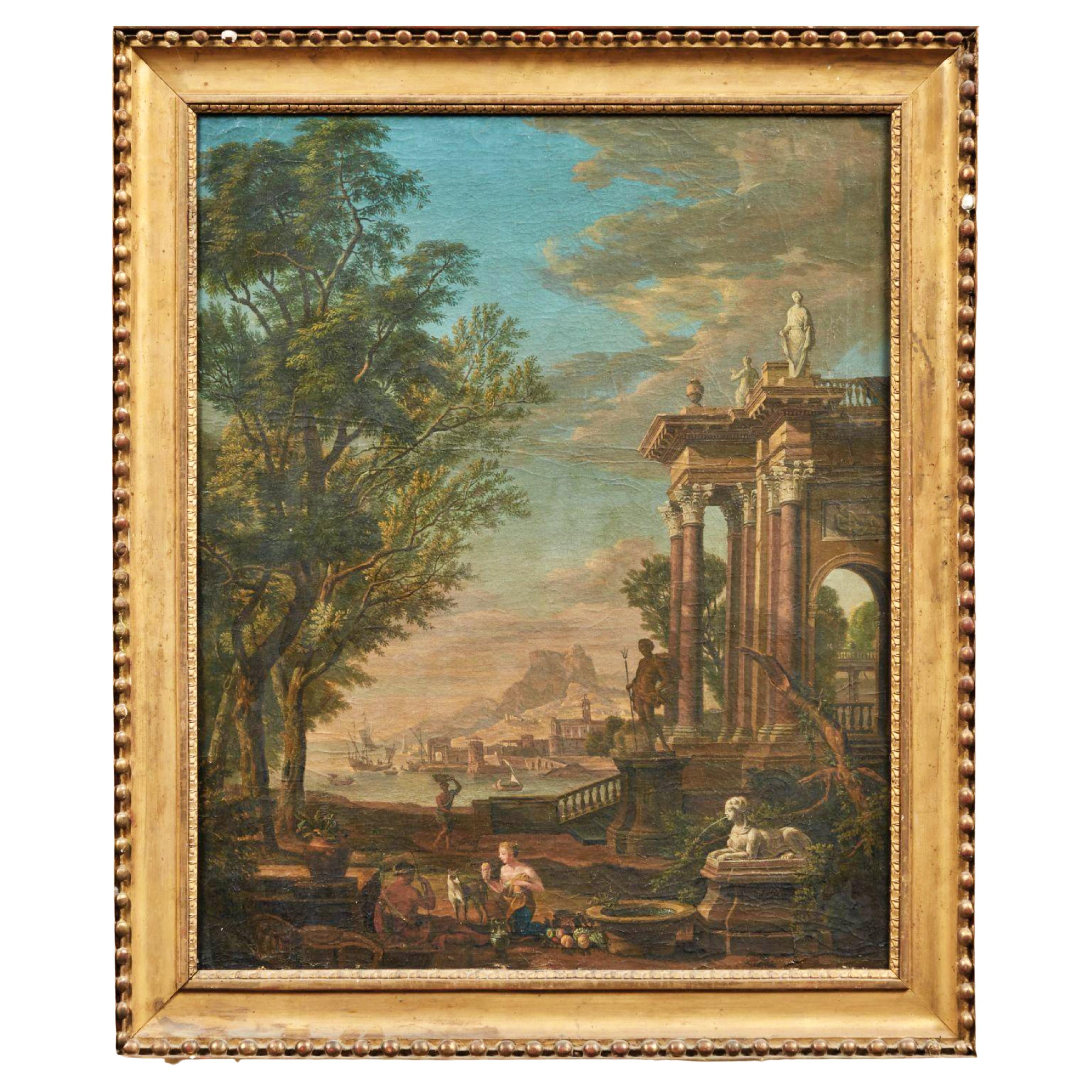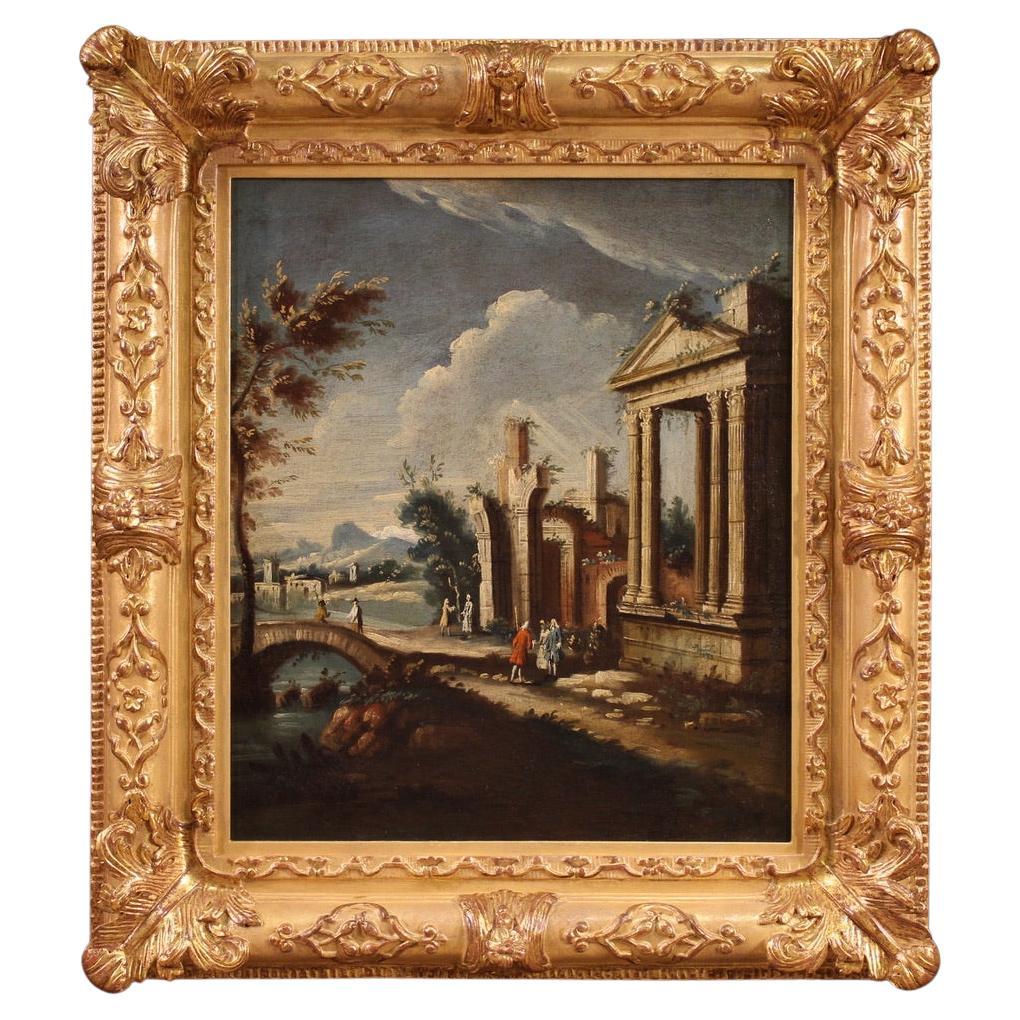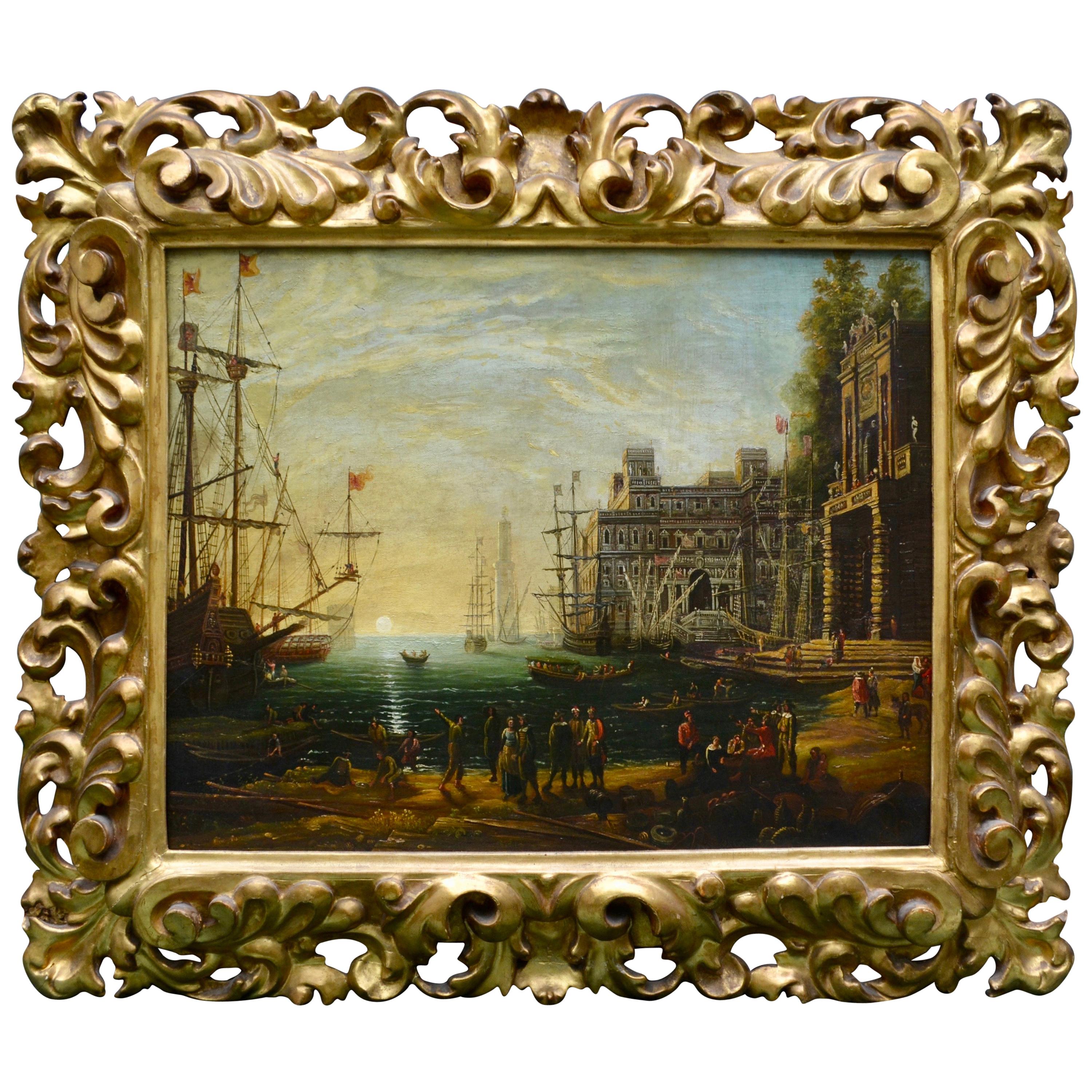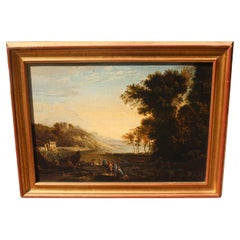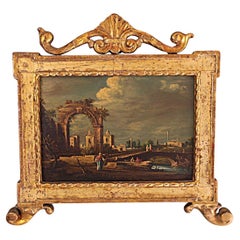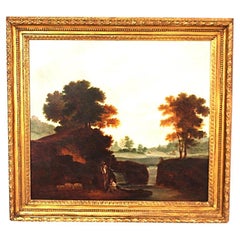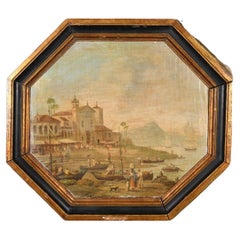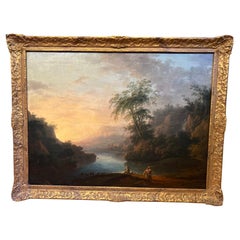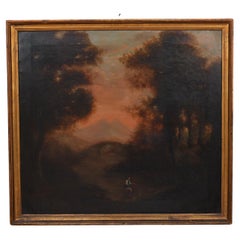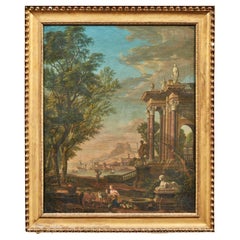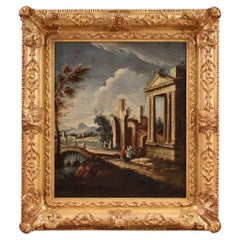Items Similar to Manner of Claude Lorrain The Goat heard in Arcadian Landscape
Video Loading
Want more images or videos?
Request additional images or videos from the seller
1 of 11
Manner of Claude Lorrain The Goat heard in Arcadian Landscape
$3,493.92
£2,550
€2,974.44
CA$4,785.80
A$5,322.86
CHF 2,779.43
MX$64,773.52
NOK 35,497.58
SEK 33,290.47
DKK 22,199.37
Shipping
Retrieving quote...The 1stDibs Promise:
Authenticity Guarantee,
Money-Back Guarantee,
24-Hour Cancellation
About the Item
An Exquisite Italianate Arcadian Landscape Oil Painting
This late 18th-century Italianate classical landscape oil painting beautifully captures the timeless elegance of Claude Lorrain-style art. Featuring an extensive pastoral scene with classical ruins, rolling countryside, and a serene Roman Campagna backdrop, this artwork embodies the Old Master landscape tradition that flourished in European art during the 17th and 18th centuries. Painted with masterful technique, this classical countryside scene in oil on canvas evokes the grandeur of Golden Age landscape art while maintaining an idyllic, Arcadian atmosphere.
Key Features of This Claude Lorrain-Style Landscape Painting:
Claude Lorrain-Inspired Composition – The painting’s soft, golden light, intricate ruins, and sweeping perspective are reminiscent of Claude Lorrain's masterful landscapes.
Romantic and Pastoral Setting – This bucolic scenery painting transports the viewer to a world of peace and tranquillity, enriched with rustic farm life and nature.
Classical Ruins and Italianate Aesthetics – Reflecting the influence of the Roman Campagna, this painting highlights the enduring beauty of antiquity.
Goat Herd and Idyllic Countryside – A carefully placed goat herd adds a charming pastoral element to this traditional landscape oil painting.
Museum-Quality Old Master Style – A high-quality oil painting that echoes the tradition of the Baroque landscape paintings of Lorrain and Poussin.
Investment-Quality Fine Art – Ideal for collectors of classical European paintings, this piece is an excellent antique reproduction landscape painting.
Perfect for Sussex Homes and Art Collectors – A timeless addition for art buyers in Sussex, UK, and beyond, this painting fits seamlessly into both traditional and contemporary interiors.
Historical Context: The Popularity of Italianate Landscape Paintings
The Influence of Claude Lorrain on Arcadian Landscape Art
Claude Lorrain (1600–1682) was a French Baroque painter whose idyllic countryside artwork defined pastoral beauty in oil painting. His work, often set in Arcadian landscapes, was characterized by balanced compositions, golden light, and classical ruins. His paintings influenced generations of artists, including British landscape painters who sought to capture similar bucolic serenity and classical grandeur.
Some of his most notable works include:
“Landscape with Ruins” (1636) – A beautifully composed classical landscape painting, depicting ancient ruins in harmony with nature.
“Pastoral Landscape with a Goatherd” – Featuring farm animals, rolling hills, and a peaceful river scene, this painting showcases Lorrain’s mastery of rural scenery.
Nicolas Poussin and the Classical Landscape Tradition
Alongside Lorrain, Nicolas Poussin (1594–1665) was another leading figure in the development of 17th-century pastoral scene painting. His structured compositions and emphasis on harmony and order laid the foundation for the antique-style oil painting movement in Europe.
Notable examples include:
“Landscape with a Calm” (1650-51) – A tranquil depiction of a Roman temple ruin, bathed in soft light and complemented by a peaceful river setting.
“Arcadian Shepherds” – A meditation on the transience of time and the timeless beauty of nature.
Both Lorrain and Poussin played a crucial role in the development of the 18th-century classical landscape painting genre, influencing numerous British and European painters.
Why Collectors and Art Enthusiasts Love This Style
1. Timeless Aesthetic Appeal
The warm, golden light and balanced compositions of Italianate pastoral landscapes make them an attractive choice for both art collectors and interior decorators. These paintings offer a sense of elegance, sophistication, and nostalgia, perfectly suited for traditional estates, fine art galleries, and antique collections.
2. Investment Value of Old Master Reproduction Paintings
The demand for Claude Lorrain-style paintings remains high among art investors and collectors. High-quality hand-painted Arcadian landscape artworks continue to appreciate in value, especially those executed in museum-quality oil on canvas.
3. Classical Landscapes in Modern Interiors
Whether displayed in a Sussex country home, London townhouse, or fine art gallery, an 18th-century style landscape painting adds a touch of classical beauty and refinement. These artworks serve as stunning centrepieces, enhancing both modern and traditional spaces.
Condition
The painting has been to our expert conservators; the painting has had a light, clean small restoration in the sky, and the canvas has been fully relined. The frame has also been restored.
Very good antique condition.
Provenance
Unsigned but is inscribed on the verso, Mary Howard, who was an avid collector of 18th century landscapes including works by Richard Wilson.
- Similar to:Claude Lorrain (Artist)
- Dimensions:Height: 26.38 in (67 cm)Width: 26.38 in (67 cm)Depth: 1.58 in (4 cm)
- Style:Baroque (In the Style Of)
- Materials and Techniques:
- Place of Origin:
- Period:
- Date of Manufacture:1790
- Condition:Refinished. Wear consistent with age and use. Has been cleaned and has some retouches in the sky. The canvas has been relined, and the frame has been repaired.
- Seller Location:Seaford, GB
- Reference Number:1stDibs: LU10376244393052
About the Seller
New to 1stDibs
Joined in the past six months.
No Reviews Yet
Vetted Professional Seller
Every seller passes strict standards for authenticity and reliability
Established in 2021
1stDibs seller since 2025
Typical response time: 1 hour
- ShippingRetrieving quote...Shipping from: Seaford, United Kingdom
- Return Policy
Authenticity Guarantee
In the unlikely event there’s an issue with an item’s authenticity, contact us within 1 year for a full refund. DetailsMoney-Back Guarantee
If your item is not as described, is damaged in transit, or does not arrive, contact us within 7 days for a full refund. Details24-Hour Cancellation
You have a 24-hour grace period in which to reconsider your purchase, with no questions asked.Vetted Professional Sellers
Our world-class sellers must adhere to strict standards for service and quality, maintaining the integrity of our listings.Price-Match Guarantee
If you find that a seller listed the same item for a lower price elsewhere, we’ll match it.Trusted Global Delivery
Our best-in-class carrier network provides specialized shipping options worldwide, including custom delivery.More From This Seller
View AllManner of Claude Lorrain Merchants on the banks of the river po
By (after) Claude Lorrain (Claude Gellée)
Located in Seaford, GB
Italianate landscape, Manner of Claude Lorrain
Very good Quality oil on relined canvas in the Manner of Claude Lorrain, cargo ships on the banks of the river Po Italy.
📜 Provenance – Italianate Landscape after Claude Lorrain, England or Italy, circa late 18th–early 19th century
This finely executed oil on canvas is an accomplished historic copy after Claude Lorrain’s celebrated Italianate river landscapes, specifically related to his Landscape with Merchants (c. 1630s), held at the National Gallery of Art, Washington, D.C. The composition also bears a close resemblance to the 1769 engraving by Boydell and James Mason, after a painting once in the distinguished collection of Robert Trevor, 4th Baron Trevor, later 1st Viscount Hampden.
The scene features cargo ships along the tranquil banks of the River Po, enveloped in the soft, atmospheric light for which Claude Lorrain (1600–1682) is universally revered. Executed in the idiom of the Grand Tour period, the painting exemplifies the classical Arcadian themes sought by aristocratic collectors travelling through Italy in the 18th and early 19th centuries.
This work is a particularly elegant example of the period's taste for Claudean compositions, balancing architectural elements with expansive vistas and golden, diffused light. The canvas has been professionally relined and restored, housed in a contemporary frame that complements the work’s scale and palette. Minor craquelure and darkening to areas of the blue and green pigments remain consistent with age, enhancing its historic charm.
Ideal for integration into neoclassical, traditional, or transitional interiors, this work represents an opportunity to acquire a piece of decorative art with a strong visual lineage and academic relevance — a testament to Lorrain’s enduring influence across centuries of landscape painting.
Very similar to the Landscape with Merchants in the National Gallery of Art, Washington, D.C.
Our version could be after the engraving by Boydell and James Mason on 1st January 1769.
Interestingly, the source painting for the painting was once in the collection of Robert Trevor, 4th Baron Trevor (from 1764), and subsequently (from 1776) 1st Viscount Hampden.
18th-Century Italian Landscape in the Manner of Claude Lorrain
This exquisite 18th-century Italian Landscape in the manner of Claude Lorrain captures the essence of Italian Baroque landscape painting, showcasing the serene beauty and harmony of the classical countryside. Drawing inspiration from the Golden Age landscape painting, it reflects the elegance and detail characteristic of Claude Lorrain-style artwork, featuring sweeping vistas, balanced compositions, and an idealised landscape scene that exudes timeless charm.
A Classical Italian Countryside Painting...
Category
Antique 18th Century British Baroque Paintings
Materials
Canvas
Antique Venetian capriccio oil painting
Located in Seaford, GB
Francesco Guardi Venice Oil Painting – Venetian Art in the Manner of Guardi
Exquisite 19th-Century Venetian Oil Painting
Experience the timeless elegance of Venetian art with this r...
Category
Early 20th Century Paintings
Materials
Pine, Paint
$1,699 Sale Price
20% Off
18th century of circle Richard Wilson pastoral Landscape
By Richard Wilson R.A.
Located in Seaford, GB
18th-Century Richard Wilson Landscape – A Masterpiece of British Old Master Art
This 18th-century Richard Wilson landscape, attributed to the circle of Thomas Jones, is a stunning pastoral landscape oil painting that embodies the charm of Georgian-era countryside artwork. As a fine example of British old master landscape art, this piece showcases the elegance and natural beauty of the English countryside, making it a perfect addition to any collection of antique rural landscape art.
A Romantic Countryside Painting with Timeless Appeal
The composition of this romantic countryside painting is thoughtfully balanced, featuring lush greenery, rolling hills, and a tranquil sky. The English countryside oil painting...
Category
Antique 18th Century English Georgian Paintings
Materials
Canvas
Early 19th century Capriccio Brazil School Painting
Located in Seaford, GB
Rare Early 19th century Capriccio view of Rio de Janeiro Painting
Probably painted circa 1810 by one of Jean-Baptiste Debret, Italian Students.
Painted on Sailcloth.
Historical Context of Early 19th Century Portuguese Colonial Brazil
1.1 Transition from Colony to Empire
During the early 19th century, Brazil underwent a seismic shift in its political status. Originally a colony under the Portuguese Empire, the arrival of the Portuguese Royal Court in Rio de Janeiro in 1808 rapidly elevated the city’s cultural and political importance. By 1815, Brazil was declared a kingdom united with Portugal, setting the stage for the emergence of the Empire of Brazil in 1822. This period of transformation—often termed the transitional period from colony to empire—fueled a wave of artistic production in cities like Rio de Janeiro.
1.2 European Artistic Influence in Brazil
With the French Artistic Mission in Rio (initiated in 1816) and the presence of various Portuguese and European artists, Brazilian art of the early 1800s began to reflect diverse influences, from neoclassical painting to the early rumblings of romanticism. Painters such as Jean-Baptiste Debret, and Nicolas-Antoine Taunay, and local luminaries like Manuel de Araújo Porto-Alegre contributed to the fine arts tradition in Brazil. Their works featured scenes of local life, portraits of Brazilian society, and imaginative vistas—sometimes referred to as “capriccios,” in which real elements were combined with artistic liberties to create an idealized panorama.
1.3 Rio de Janeiro as Cultural and Political Hub
Rio de Janeiro, often called the Imperial capital after Brazil’s independence, was home to foundational institutions like the Imperial Academy of Fine Arts (Academia Imperial de Belas Artes). Later evolving into the Escola de Belas Artes (School of Fine Arts in Rio), these academies nurtured the talents of emerging painters, who found patronage under the Royal Court and, subsequently, the Imperial Court. The city’s significance was further enhanced by the construction of significant buildings, the modernization of infrastructure, and the mingling of European courtly customs with the traditions of local inhabitants.
. Description of the Octagonal Oil on Canvas: A Capriccio View of Rio de Janeiro
2.1 Composition and Layout
The most striking characteristic of this 19th-century Brazilian art piece is its octagonal shape, a relatively unusual format that draws the viewer’s gaze toward its centre. The composition showcases Rio de Janeiro’s shoreline in the early 1800s, brimming with merchant ships and smaller boats anchored near the shore. On the sand, there is a bustling crowd of local people—men and women carrying food and goods on their heads, loading and unloading boats, and engaging in everyday commerce. The backdrop of soaring mountains suggests Rio’s iconic topography, embodying the landscape that famously defines the city.
2.2 Architectural and Religious Landmarks
On the left side, one can discern the silhouette of a church believed to be Santa Lucia, a significant religious structure in the heart of early 19th-century Rio. This element provides viewers with a tangible reference point, linking the scene to an actual location. However, because this painting is labelled as a “capriccio,” the artist might have taken creative liberties by rearranging or amplifying certain features of the city. The melding of real and idealized elements is characteristic of these imaginative vistas.
2.3 Evoking Daily Life in Colonial Rio
One of the painting’s greatest appeals lies in its portrayal of daily life during the colonial era. Men and women from various backgrounds populate the scene. Some appear to be carrying goods on their heads, a common practice in Brazil that has persisted through different centuries. Others appear to be haggling or trading near small vessels, revealing the commercial pulse of an active port city. This focus on local people, combined with the grandeur of merchant ships, captures the tension and synergy between the every day and the extraordinary—a hallmark of Brazilian colonial painting that balances the grand narratives of empire with the rhythms of ordinary life.
2.4 An Amalgamation of Neoclassical and Romantic Influences
Although academic art in early 19th century Brazil was highly influenced by neoclassicism, the onset of romanticism can be spotted in the emotional portrayal of the sky, the lively palette, and the dramatic emphasis on nature’s beauty (the mountains, in particular). This duality reflects the fine arts tradition in Brazil during the transitional phase when artists were embracing multiple styles. As part of the School of Rio or the Rio de Janeiro school, painters often integrated academic techniques learned from European masters with emerging local subjects and influences.
3. Institutions and Artistic Movements
3.1 Imperial Academy of Fine Arts
Originally known as the Royal School of Sciences, Arts, and Crafts, the Imperial Academy of Fine Arts in Rio de Janeiro was instrumental in shaping 19th-century Brazilian art. Influential artists and teachers from Portugal, France, and other European nations congregated at the Academy, imparting their expertise to native students. As the monarchy consolidated power, the Academy enjoyed royal patronage, leading to the creation of Imperial Academy-style works that combined European academic rigour with Brazilian-themed subject matter.
3.2 Impact of the French Artistic Mission
The French Artistic Mission, which arrived in 1816, played a pivotal role in introducing advanced European artistic techniques, thereby elevating the overall quality of painting in Brazil. Artists like Jean-Baptiste Debret not only documented Brazilian society but also spearheaded the development of a local visual identity that aligned with both academicism and the national context of a blossoming empire. Debret, alongside others such as Nicolas-Antoine Taunay, mentored Brazilian artists, sowing the seeds of what would become the Brazilian academic art movement.
3.3 Religious, Historical, and Landscape Paintings
In addition to everyday scenes and historical compositions, religious iconography remained crucial throughout Portuguese colonial and imperial Brazil. Churches were omnipresent in cityscapes like Rio de Janeiro. Many colonial-era Brazilian portraits...
Category
Antique Early 19th Century Brazilian Spanish Colonial Paintings
Materials
Canvas
$2,959 Sale Price
20% Off
Early 19th century horse painting
By Dean Wolstenholme
Located in Seaford, GB
A Timeless Depiction of the English Fox Hunt
The early 19th-century fox hunting scene, attributed to Dean Wolstenholme Elder, is a stunning representation of the aristocratic traditi...
Category
Antique 1810s English Regency Paintings
Materials
Canvas
Dutch 19th century Landscape Painting
By Andreas Schelfhout
Located in Seaford, GB
This charming oil-on-paper painting captures a serene landscape near Haarlem, evocative of Andreas Schelfhout's masterful Dutch Romantic style. The work features a quintessentially D...
Category
Antique Late 19th Century Dutch Late Victorian Paintings
Materials
Paint, Paper
You May Also Like
18th Century, Old Master European Landscape Painting Italian School
Located in Atlanta, GA
Italian School, 18th century.
A masterful example of 18th-century Italian School artistry, this Old Master landscape painting captures the sublime beauty of an idealized European co...
Category
Antique 18th Century Italian Baroque Paintings
Materials
Canvas, Giltwood, Paint
$6,000 Sale Price
20% Off
17th Century Oil Painting School of Claude Lorrain
By (after) Claude Lorrain (Claude Gellée)
Located in 263-0031, JP
A copy of the 1636 painting “River Ford” by the French proto-plein-air painter Claude Lorrain (1600-1682). This suivier, or follower, has faithfully reproduced the original but revis...
Category
Antique 17th Century European Paintings
Materials
Canvas
18th Century French School, after I. de Moucheron "Landscape with a Fountain"
Located in Madrid, ES
18th century French School, after I. de Moucheron,
Landscape with a Fountain,
canvas, monogrammed lower right «JBF»,
with restorations
67 x 55 CM - 26,4 x 21,7 IN.
good condition
Category
Antique 18th Century French Baroque Wallpaper
Materials
Paint
18th Century Oil on Canvas Venetian Architectural Capriccio Landscape Painting
Located in Vicoforte, Piedmont
Refined Italian landscape from the second half of the 18th century. Oil painting on canvas depicting a splendid view with ancient ruins and figures in Venetian dress, of remarkable p...
Category
Antique 1760s Italian Paintings
Materials
Canvas
18th Century Copy of "Port Scene with the Villa Medici" after Claude Lorrain
By Claude Lorrain
Located in Vancouver, British Columbia
A late 18th century copy of a painting by Claude Lorrain titled, "Port scene with the Villa Medici" the original painted in 1637 and now hanging in the Uffizi Gallery in Florence. Th...
Category
Antique Late 18th Century Italian Baroque Paintings
Materials
Canvas
$3,250 Sale Price
50% Off
Late 18th-Early 19th Century Continental Landscape Painting
Located in Chapel Hill, NC
Late 18th-early 19th century capriccio (imaginary) landscape, Continental. A shepherd & animals at hillside "barns" below Italianate church & fortress. Acquired in the late 1940s by ...
Category
Antique Early 19th Century European Romantic Paintings
Materials
Canvas
More Ways To Browse
Vintage 18 Wheelers
Vintage German Teapots
Vintage Green Glass Footed Bowl
Vintage Skates
Vintage Stone Crusher
Vintage Stone Shoes
Windsor Dining Table
16th Century Bed
800 Silver Tea Set
Abercrombie Leather
Abhaya Mudra
African Container
Antique 2 Over 3 Chest Of Drawers
Antique Barrow
Antique Chinese Porcelain Statues
Antique Desk Globe
Antique Dirk
Antique Figurehead
